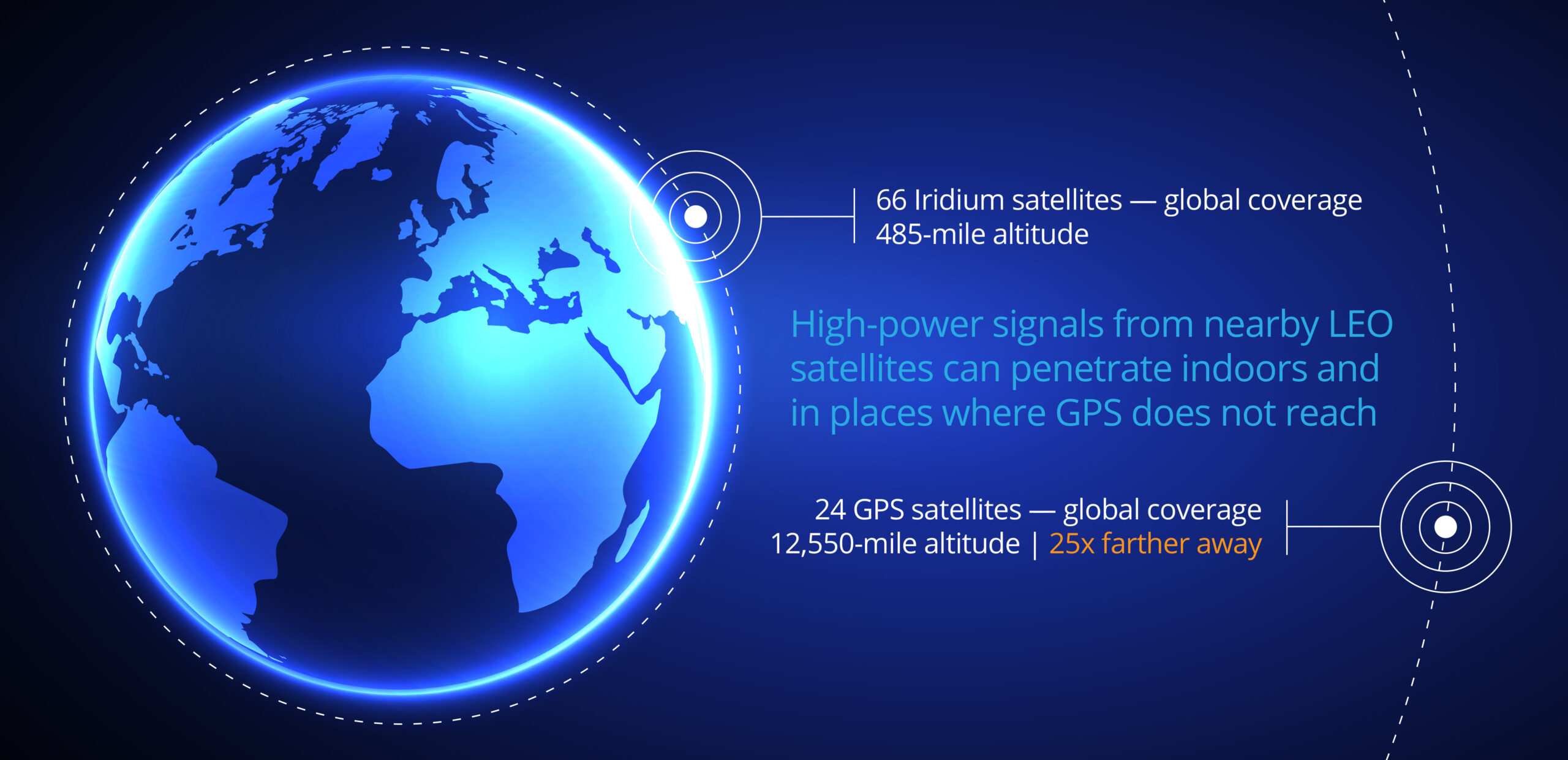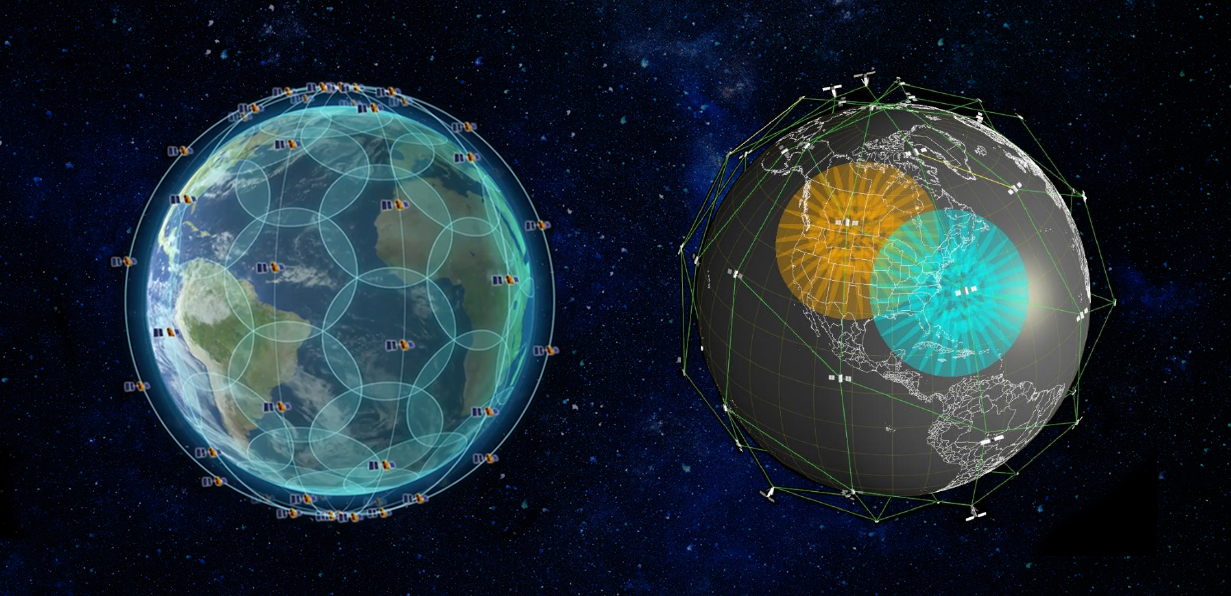
Powerful, worldwide, and continuous — everything organizations need in their positioning, navigation, and timing (PNT) services, and all words that accurately describe STL (Satellite Time and Location).
STL from Satelles provides customers around the globe with a positioning, navigation, and timing (PNT) service using low Earth orbit (LEO) satellites. STL is unique in that it’s the only PNT available today using LEO signals which are more powerful, extremely secure, and available worldwide.
The high-power signals complement GPS (and other GNSS) by reaching into challenging environments where GPS signals are obstructed or degraded, including indoors and occluded environments. The complex, overlapping beam patterns of the satellites, combined with signal authentication techniques, allow STL to deliver a trusted time and location capability like no other.
Plus, STL is easy to deploy and connect, saving time and money while delivering reliable and precise PNT.
Powerful Signal
STL broadcasts are much stronger than GPS satellites in medium Earth orbit (MEO) thanks to the proximity of LEO satellites (25 times closer to the Earth than GNSS satellites) and patented signal coding gains.
Signals are transmitted over a unique high-power channel. When combined with the proximity of LEO and the signal coding gain, the STL broadcast produces a signal that is 1,000 times (30 dB) more powerful than any GNSS signal.

Worldwide Availability
An innovative mesh architecture of 66 polar-orbit LEO satellites forms an efficient and flexible global network in space to ensure a robust time and location service everywhere — including urban and rural locations, and across oceans, airways, and polar regions.
Cybersecurity
Cross-links provide continuous orbit and time information about the entire constellation even when most are not in view. Overlapping spot beams provide location-specific keys that change frequently to broadcast a signal that is unpredictable in advance to deliver unparalleled security.

Continuous Signals
With STL, continuous signals are available from everywhere in the sky. LEO satellites travel at speeds of approximately 17,000 mph (an eight-minute horizon-to-horizon transit), resulting in carrier frequency variations due to Doppler effects.
Look angles in the sky are continuously changing due to the satellites’ rapidly traversing orbits, making it possible for the STL transmission to reach receivers in even the most challenging locations.
These are just some of the attributes of STL that help improve multipath and avoid many error sources inherent to GPS/GNSS.

The Benefits of LEO PNT
GPS and other GNSS operate mostly in medium Earth orbit (MEO). Other solutions – such as LEO satellites, terrestrial wireless infrastructure, network time transfer, and signals of opportunity – are essential contingency capabilities that protect the operations of PNT-dependent systems, ensure the survivability and resilience of critical infrastructure, and preserve the continuity of government.
STL falls into the LEO satellite category. LEO constellations have different operational features and performance characteristics than MEO systems, such as increased signal strength and enhanced security. LEO-based solutions bring coverage to every spot on the planet.
With multiple satellites in a LEO constellation, Satelles provides 3-D location information in addition to precise timing. This contrasts with wide-area ground-based PNT systems — most notably those that rely on terrestrial wireless infrastructure – which only can provide 2-D positioning without deploying substantial supplemental infrastructure to support 3-D.
LEO PNT also has benefits versus other non-satellite technologies. Compared to terrestrial radio frequency (RF) sources of PNT, for example, STL is available globally and does not require infrastructure to be deployed on a city-by-city basis. Additionally, a LEO PNT service like STL it is not susceptible to physical attacks like that which could be made against a broadcast tower.
Not All Forms of LEO PNT Are the Same
The satellite market is growing rapidly due to the advent of low Earth orbit (LEO) smallsat spacecraft that can be launched and operated less expensively than higher altitude satellites in medium Earth orbit (MEO) or geosynchronous orbit (GEO). However, there is a tremendous amount of diversity among LEO satellite constellations in terms of signal engineering, power, geographic coverage, as well as the ability to provide trustworthy PNT to end users.
STL has been continuously operational since 2016 and remains as the only commercially available source of LEO PNT in the market today. The STL signal has been specifically engineered to provide high-quality and completely reliable PNT. What’s more, Satelles delivers STL as a comprehensive service with a dedicated R&D team, a robust ground network, expert technical support and customer service capabilities, and multiple receiver options.
As some experts have noted, LEO isn’t a technology; rather, it’s a neighborhood in space that supports multiple technology platforms, each with their own unique capabilities.

Can You Back Up Space with Space?
The answer is a resounding “yes.”
Most potential disruptions to GPS satellites in medium Earth orbit (MEO) are NOT common mode with low Earth orbit (LEO) satellites.
Due to their orbit-level characteristics, LEO satellite constellations are:
- better protected by the Earth’s magnetosphere than MEO (e.g., GPS) or GEO space vehicles
- less susceptible to the effects of internal charging and surface charging
- less vulnerable to orbital drag potentially caused by solar storms
- negligibly impacted by individual satellite outages due to the higher number of space vehicles